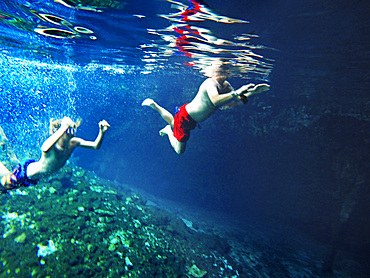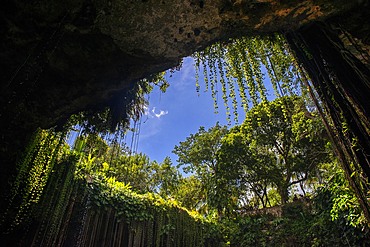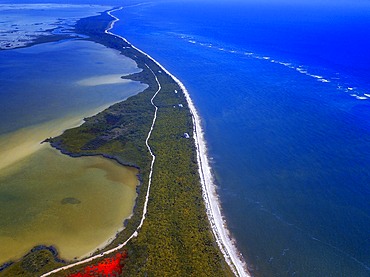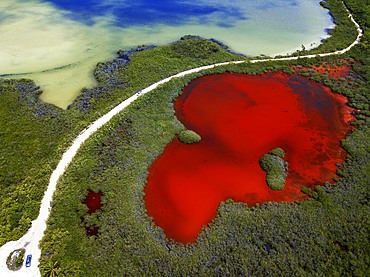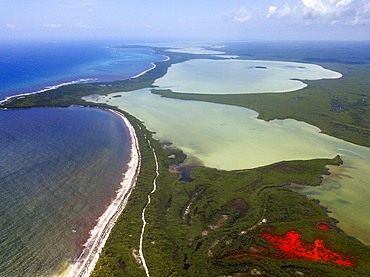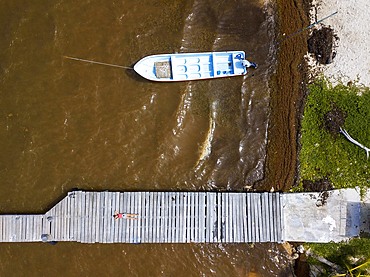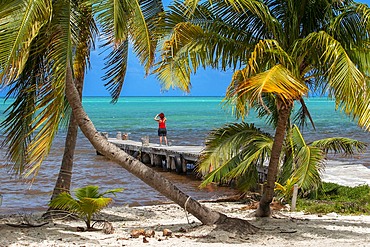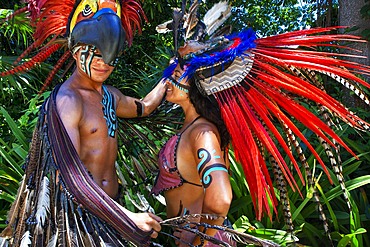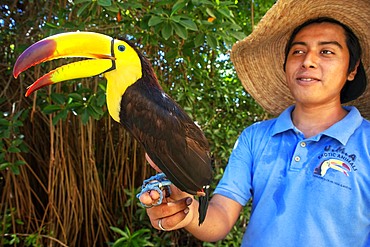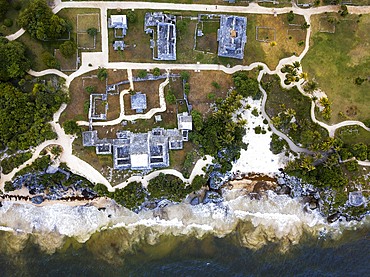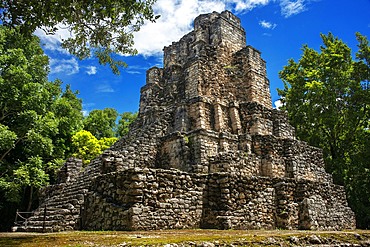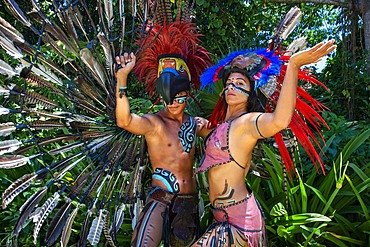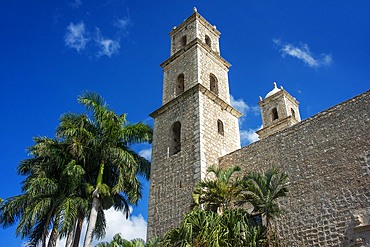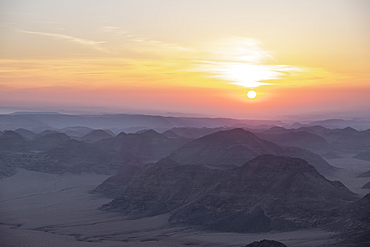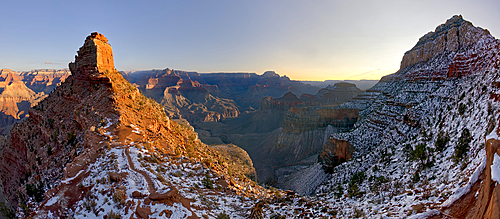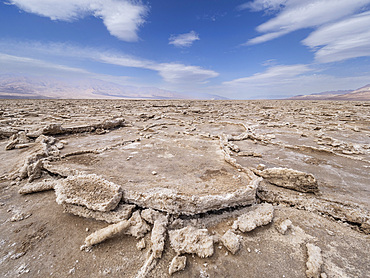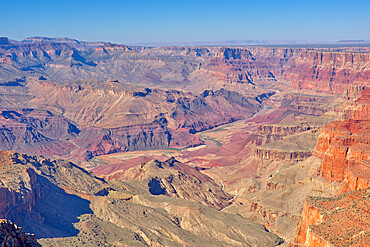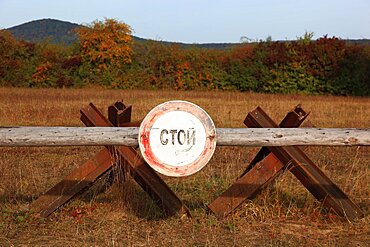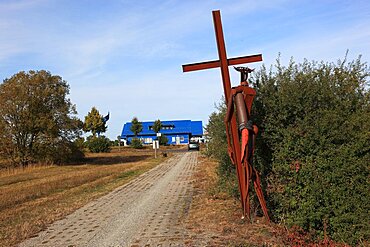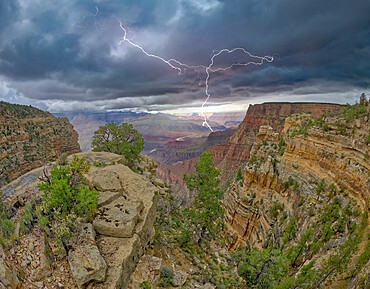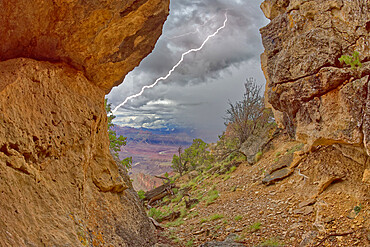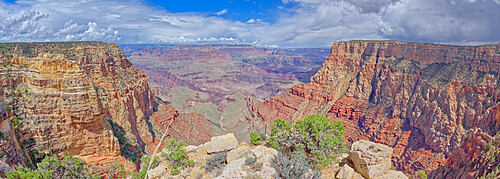Recent searches
Loading...
1350-6635 - Aerial view of Mayan Ruin of Chichen Itza Archaeological Site Yucatan Peninsula, Quintana Roo, Caribbean Coast, Mexico
1350-6630 - Swimming at Cenote Ik Kil in Yucatan, Mexico, a natural pit, or sinkhole near Chichen Itza. Yucatan Peninsula, Quintana Roo, Mexico. Ik Kil was sacred to the Mayans who used this cenote for both relaxation and ritual services centuries ago.
1350-6633 - Gran Cenote de Tulum in Yucatan Peninsula, Quintana Roo, Mexico. There are thousands of cenotes dotted all over Mexico���s Yucatan Peninsula, and their existence is as much a defining characteristic of the region as is the distinct geological feature from which they result. Once revered by the ancient Mayans as sacred wells, they are now magnets for tourists, adventurers, and explorers alike.
1350-6628 - Cenote Ik Kil in Yucatan, Mexico, a natural pit, or sinkhole near Chichen Itza. Yucatan Peninsula, Quintana Roo, Mexico. Ik Kil was sacred to the Mayans who used this cenote for both relaxation and ritual services centuries ago.
1350-6627 - Aerial view of Punta Allen Sian Ka'an Reserve, Yucatan Peninsula, Mexico. Red lagoon near Boca Paila Bridge.
In the language of the Mayan peoples who once inhabited this region, Sian Ka'an means Origin of the Sky. Located on the east coast of the Yucatán peninsula, this biosphere reserve contains tropical forests, mangroves and marshes, as well as a large marine section intersected by a barrier reef. It provides a habitat for a remarkably rich flora and a fauna comprising more than 300 species of birds, as well as a large number of the region's characteristic terrestrial vertebrates, which cohabit in the diverse environment formed by its complex hydrological system.
Along its roughly 120 kilometres of coastline, the property covers over 400,000 hectares of land ranging from sea level to only ten m.a.s.l. The property boasts diverse tropical forests, palm savannah, one of the most pristine wetlands in the region, lagoons, extensive mangrove stands, as well as sandy beaches and dunes. The 120,000 hectares of marine area protect a valuable part of the Mesoamerican Barrier Reef and seagrass beds in the shallow bays. The lush green of the forests and the many shades of blue of the lagoons and the Caribbean Sea under a wide sky offer fascinating visual impressions.
1350-6623 - Aerial view of Punta Allen Sian Ka'an Reserve, Yucatan Peninsula, Mexico. Red lagoon near Boca Paila Bridge.
In the language of the Mayan peoples who once inhabited this region, Sian Ka'an means Origin of the Sky. Located on the east coast of the Yucatán peninsula, this biosphere reserve contains tropical forests, mangroves and marshes, as well as a large marine section intersected by a barrier reef. It provides a habitat for a remarkably rich flora and a fauna comprising more than 300 species of birds, as well as a large number of the region's characteristic terrestrial vertebrates, which cohabit in the diverse environment formed by its complex hydrological system.
Along its roughly 120 kilometres of coastline, the property covers over 400,000 hectares of land ranging from sea level to only ten m.a.s.l. The property boasts diverse tropical forests, palm savannah, one of the most pristine wetlands in the region, lagoons, extensive mangrove stands, as well as sandy beaches and dunes. The 120,000 hectares of marine area protect a valuable part of the Mesoamerican Barrier Reef and seagrass beds in the shallow bays. The lush green of the forests and the many shades of blue of the lagoons and the Caribbean Sea under a wide sky offer fascinating visual impressions.
1350-6625 - Aerial view of Punta Allen Sian Ka'an Reserve, Yucatan Peninsula, Mexico. Red lagoon near Boca Paila Bridge.
In the language of the Mayan peoples who once inhabited this region, Sian Ka'an means Origin of the Sky. Located on the east coast of the Yucatán peninsula, this biosphere reserve contains tropical forests, mangroves and marshes, as well as a large marine section intersected by a barrier reef. It provides a habitat for a remarkably rich flora and a fauna comprising more than 300 species of birds, as well as a large number of the region's characteristic terrestrial vertebrates, which cohabit in the diverse environment formed by its complex hydrological system.
Along its roughly 120 kilometres of coastline, the property covers over 400,000 hectares of land ranging from sea level to only ten m.a.s.l. The property boasts diverse tropical forests, palm savannah, one of the most pristine wetlands in the region, lagoons, extensive mangrove stands, as well as sandy beaches and dunes. The 120,000 hectares of marine area protect a valuable part of the Mesoamerican Barrier Reef and seagrass beds in the shallow bays. The lush green of the forests and the many shades of blue of the lagoons and the Caribbean Sea under a wide sky offer fascinating visual impressions.
1350-6620 - Aerial view of Punta Allen Sian Ka'an Reserve, Yucatan Peninsula, Mexico. Red lagoon near Boca Paila Bridge.
In the language of the Mayan peoples who once inhabited this region, Sian Ka'an means Origin of the Sky. Located on the east coast of the Yucatán peninsula, this biosphere reserve contains tropical forests, mangroves and marshes, as well as a large marine section intersected by a barrier reef. It provides a habitat for a remarkably rich flora and a fauna comprising more than 300 species of birds, as well as a large number of the region's characteristic terrestrial vertebrates, which cohabit in the diverse environment formed by its complex hydrological system.
Along its roughly 120 kilometres of coastline, the property covers over 400,000 hectares of land ranging from sea level to only ten m.a.s.l. The property boasts diverse tropical forests, palm savannah, one of the most pristine wetlands in the region, lagoons, extensive mangrove stands, as well as sandy beaches and dunes. The 120,000 hectares of marine area protect a valuable part of the Mesoamerican Barrier Reef and seagrass beds in the shallow bays. The lush green of the forests and the many shades of blue of the lagoons and the Caribbean Sea under a wide sky offer fascinating visual impressions.
1350-6616 - Aerial view of Punta Allen Sian Ka'an Reserve, Yucatan Peninsula, Mexico.
In the language of the Mayan peoples who once inhabited this region, Sian Ka'an means Origin of the Sky. Located on the east coast of the Yucatán peninsula, this biosphere reserve contains tropical forests, mangroves and marshes, as well as a large marine section intersected by a barrier reef. It provides a habitat for a remarkably rich flora and a fauna comprising more than 300 species of birds, as well as a large number of the region's characteristic terrestrial vertebrates, which cohabit in the diverse environment formed by its complex hydrological system.
Along its roughly 120 kilometres of coastline, the property covers over 400,000 hectares of land ranging from sea level to only ten m.a.s.l. The property boasts diverse tropical forests, palm savannah, one of the most pristine wetlands in the region, lagoons, extensive mangrove stands, as well as sandy beaches and dunes. The 120,000 hectares of marine area protect a valuable part of the Mesoamerican Barrier Reef and seagrass beds in the shallow bays. The lush green of the forests and the many shades of blue of the lagoons and the Caribbean Sea under a wide sky offer fascinating visual impressions.
1350-6615 - Palms and old pier in Punta Allen Sian Ka'an Reserve, Yucatan Peninsula, Mexico.
In the language of the Mayan peoples who once inhabited this region, Sian Ka'an means Origin of the Sky. Located on the east coast of the Yucatán peninsula, this biosphere reserve contains tropical forests, mangroves and marshes, as well as a large marine section intersected by a barrier reef. It provides a habitat for a remarkably rich flora and a fauna comprising more than 300 species of birds, as well as a large number of the region's characteristic terrestrial vertebrates, which cohabit in the diverse environment formed by its complex hydrological system.
Along its roughly 120 kilometres of coastline, the property covers over 400,000 hectares of land ranging from sea level to only ten m.a.s.l. The property boasts diverse tropical forests, palm savannah, one of the most pristine wetlands in the region, lagoons, extensive mangrove stands, as well as sandy beaches and dunes. The 120,000 hectares of marine area protect a valuable part of the Mesoamerican Barrier Reef and seagrass beds in the shallow bays. The lush green of the forests and the many shades of blue of the lagoons and the Caribbean Sea under a wide sky offer fascinating visual impressions.
1350-6611 - Underwater close up view of open coral polyp during a dive, Cancun, Quintana Roo, Mexico
1350-6608 - Mexican aztec dress gods at Grand Palladium White Sand Resort and Spa in Riviera Maya, Yucatan Peninsula, Quintana Roo, Caribbean Coast, Mexico.
Aztec clothing was generally loose fitting and did not completely cover the body. When the Spanish arrived in Mexico, the people were surprised to see them in their full armour, with only their faces exposed.
Aztec clothes were generally made of cotton (which was imported) or ayate fiber, made from the Maguey Cactus (also called the Century Plant or American Aloe). Women would weave the fibers into clothing, a task girls were taught as young teenagers. Because of their vast trading network, the Aztecs were able to make use of a beautiful array of dyes, creating the brilliant
1350-6609 - Kayakking in front of the beach of Grand Palladium White Sand Resort and Spa in Riviera Maya, Yucatan Peninsula, Quintana Roo, Caribbean Coast, Mexico
1350-6606 - A Mexican staff member holds a tucan at Grand Palladium White Sand Resort and Spa in Riviera Maya, Yucatan Peninsula, Quintana Roo, Caribbean Coast, Mexico
1350-6602 - Aerial view of Grand Palladium White Sand Resort and Spa in Riviera Maya, Yucatan Peninsula, Quintana Roo, Caribbean Coast, Mexico
1350-6597 - Aerial views of El Castillo and the Ruins of the Mayan temple grounds at Tulum, Quintana Roo, Yucatan, Mexico. Tulum is the site of a pre-Columbian Mayan walled city which served as a major port for Coba, in the Mexican state of Quintana Roo. The ruins are situated on 12 meter 39 ft tall cliffs along the east coast of the Yucatán Peninsula on the Caribbean Sea in the state of Quintana Roo, Mexico. Tulum was one of the last cities built and inhabited by the Maya; it was at its height between the 13th and 15th centuries and managed to survive about 70 years after the Spanish began occupying Mexico. Old World diseases brought by the Spanish settlers appear to have resulted in very high fatalities, disrupting the society, and eventually causing the city to be abandoned.
1350-6599 - Aerial views of El Castillo and the Ruins of the Mayan temple grounds at Tulum, Quintana Roo, Yucatan, Mexico. Tulum is the site of a pre-Columbian Mayan walled city which served as a major port for Coba, in the Mexican state of Quintana Roo. The ruins are situated on 12 meter 39 ft tall cliffs along the east coast of the Yucatán Peninsula on the Caribbean Sea in the state of Quintana Roo, Mexico. Tulum was one of the last cities built and inhabited by the Maya; it was at its height between the 13th and 15th centuries and managed to survive about 70 years after the Spanish began occupying Mexico. Old World diseases brought by the Spanish settlers appear to have resulted in very high fatalities, disrupting the society, and eventually causing the city to be abandoned.
1350-6596 - Estructura 8I-13 El Castillo at Chunyaxche Muyil Maya ruins, rainforest near Tulum, Yucatan Peninsula, Quintana Roo, Mexico
1350-6595 - Mexican aztec dress gods at Grand Palladium White Sand Resort and Spa in Riviera Maya, Yucatan Peninsula, Quintana Roo, Caribbean Coast, Mexico.
Aztec clothing was generally loose fitting and did not completely cover the body. When the Spanish arrived in Mexico, the people were surprised to see them in their full armour, with only their faces exposed.
Aztec clothes were generally made of cotton (which was imported) or ayate fiber, made from the Maguey Cactus (also called the Century Plant or American Aloe). Women would weave the fibers into clothing, a task girls were taught as young teenagers. Because of their vast trading network, the Aztecs were able to make use of a beautiful array of dyes, creating the brilliant
1350-6446 - Colorful sunset over Junction Butte and Grandview Point with a sea of clouds below. Canyonlands National Park, Utah.
1350-6445 - Sunset light on the Shafer Canyon Overlook in the Island in the Sky District, Canyonlands National Park, Utah. Dead Horse Point at left with the La Sal Mountains behind.
1350-6437 - First light at sunrise on the Wingate cliffs of Junction Butte & Grandview Point with a sea of clouds below. Canyonlands NP, Utah. A winter temperature inversion produce this weather phenomenon.
1350-6654 - The Parque Hidalgo and statue of Manuel Cepeda Peraza and The San Ildefonso Cathedral in Mérida, the capital and largest city in the Yucatan State and Yucatán Peninsula, Mexico
1350-6653 - Horse drawn carriages on a city street in front of the plaza grande square, Merida, the capital city of the Yucatan, Mexico Latin America
1350-6652 - The Bishop's Palace or Peninsula Athenaeum and The San Ildefonso Cathedral in Mérida, the capital and largest city in the Yucatan State and Yucatán Peninsula, Mexico
1350-6650 - Merida Mexico - the Merida city sign in the Plaza Grande, Merida, the capital city of the Yucatan, Mexico Latin America
1350-6649 - Portal Maya sculpture Mayan Gateway situated in Parque Fundadores by sculptor Jose Arturo Tavares in Playa del Carmen, Riviera Maya, Quintana Roo, Mexico
1350-6648 - White Mexican church and street art at 5th Avenue, Playa del Carmen, Caribe, Quintana Roo state, Mayan Riviera, Yucatan Peninsula, Mexico
1350-6646 - Colorful Mexican ceramic skulls or calaveras and Frida Kahlo souvenirs in Playa del Carmen, Riviera Maya, Quintana Roo, Mexico
1350-6645 - El Castillo, The Pyramid of Kukulkán, is the Most Popular Building in the UNESCO Mayan Ruin of Chichen Itza Archaeological Site Yucatan Peninsula, Quintana Roo, Caribbean Coast, Mexico
1350-6644 - The Church and Nunnery at Chichen Itza Archaeological Site in Yucatan Peninsula, Quintana Roo, Caribbean Coast, Mexico
1350-6643 - Stony stairs of tomb of the High Priest pyramid at Chichen Itza Archaeological Site in Yucatan Peninsula, Quintana Roo, Caribbean Coast, Mexico
1350-6642 - The Great Ball Court in the Mayan Ruins of Chichen Itza Archaeological Site Yucatan Peninsula, Quintana Roo, Caribbean Coast, Mexico
1350-6640 - Serpent head sculpture in Mayan Ruin of Chichen Itza Archaeological Site in Yucatan Peninsula, Quintana Roo, Caribbean Coast, Mexico
1350-6639 - El Castillo, The Pyramid of Kukulkán, is the Most Popular Building in the UNESCO Mayan Ruin of Chichen Itza Archaeological Site Yucatan Peninsula, Quintana Roo, Caribbean Coast, Mexico
1350-6637 - El Castillo, The Pyramid of Kukulkán, is the Most Popular Building in the UNESCO Mayan Ruin of Chichen Itza Archaeological Site Yucatan Peninsula, Quintana Roo, Caribbean Coast, Mexico. Asian tour leder dressed in a maya style.
1350-6638 - El Castillo, The Pyramid of Kukulkán, is the Most Popular Building in the UNESCO Mayan Ruin of Chichen Itza Archaeological Site Yucatan Peninsula, Quintana Roo, Caribbean Coast, Mexico
1336-754 - Sunrise from the top of the Umm ad Dami mountain, the highest point in the country, Jordan, Middle East
1311-595 - View of Yuma Point from Hermit Trail in winter at Grand Canyon, Grand Canyon National Park, UNESCO World Heritage Site, Arizona, United States of America, North America
1311-592 - Hermit Canyon at Grand Canyon viewed from the east side of Yuma Point along the Boucher Trail with Pima Point on the upper right, Grand Canyon National Park, UNESCO World Heritage Site, Arizona, United States of America, North America
1311-591 - View of Hermit Canyon and Hermit Basin from the Boucher Trail at Grand Canyon with Pima Point on the upper left, Grand Canyon National Park, UNESCO World Heritage Site, Arizona, United States of America, North America
1311-590 - View of Hermit Canyon from the east side of Yuma Point at Grand Canyon Arizona along the Boucher Trail with Pima Point on the upper right, Grand Canyon National Park, UNESCO World Heritage Site, Arizona, United States of America, North America
1311-586 - View of Pipe Creek from the west cliff of Skeleton Point at Grand Canyon Arizona along the South Kaibab Trail.
1311-585 - Sunrise view from Cedar Ridge along the South Kaibab Trail at Grand Canyon Arizona in winter. O'Neill Butte is on the left and Cremation Creek is below in the center. Ooh Aah Point in on the upper right.
1311-582 - The Colorado River viewed from the Palisades of the Desert near Comanche Point at Grand Canyon Arizona.
1311-576 - The snowy cliffs of Desert View Point on the left with the Palisades on the right at Grand Canyon National Park Arizona.
1241-389 - Naval Memorial at Point Pleasant Park at sunset, Halifax, Nova Scotia, Canada
1241-383 - Purcell Landing, Point Pleasant Park at sunset, Halifax, Nova Scotia, Canada
1241-380 - Point Pleasant Park at sunset in Autumn, Halifax, Nova Scotia, Canada
1359-93 - Detail of hoodoos and trees, Sunset Point, Bryce Canyon National Park, Utah, USA
1359-92 - Full frame abstract shot of natural rock formations at Zabriskie Point at sunrise, Death Valley National Park, California, USA
1359-90 - Olmsted Point with distant view of Half Dome rock formation, Yosemite National Park, California, USA
1359-85 - Red rock formations near Sunset Point, Capitol Reef National Park, Utah, USA
1359-74 - Scenic view of Grand Canyon from Ooh Aah Point on South Kaibab Trail, Grand Canyon National Park, Arizona, USA
1359-65 - Manly Beacon rock formation at Zabriskie Point at dawn, Death Valley National Park, California, USA
1359-61 - Tree and rocks, Olmsted Point, Yosemite National Park, California, USA
1359-59 - Olmsted Point with distant view of Half Dome rock formation, Yosemite National Park, California, USA
1359-60 - Tree and rocks, Olmsted Point, Yosemite National Park, California, USA
1112-7129 - The Salt Flats of Badwater Basin, the lowest point in North America, Death Valley National Park, California, United States of America, North America
1112-7128 - The Salt Flats of Badwater Basin, the lowest point in North America, Death Valley National Park, California, United States of America, North America
1112-7124 - A view of Zabriskie Point at sunset, Amargosa Range, Death Valley National Park, California, United States of America, North America
1112-7123 - A view of Zabriskie Point at sunset, Amargosa Range, Death Valley National Park, California, United States of America, North America
1112-7127 - The Salt Flats of Badwater Basin, the lowest point in North America, Death Valley National Park, California, United States of America, North America
1112-7091 - Fish racks, Musken (Masske), a Sami village near Hellemobotn, the narrowest point of Norway, Nordland, Norway, Scandinavia, Europe
1112-7090 - Fish racks, Musken (Masske), a Sami village near Hellemobotn, the narrowest point of Norway, Nordland, Norway, Scandinavia, Europe
1112-7093 - Musken (Masske), a Sami village near Hellemobotn, the narrowest point of Norway, Nordland, Norway, Scandinavia, Europe
1112-7092 - Musken (Masske), a Sami village near Hellemobotn, the narrowest point of Norway, Nordland, Norway, Scandinavia, Europe
1112-7094 - Musken (Masske), a Sami village near Hellemobotn, the narrowest point of Norway, Nordland, Norway, Scandinavia, Europe
1311-531 - Grand Canyon viewed west of Navajo Point, Grand Canyon National Park, UNESCO World Heritage Site, Arizona, United States of America, North America
1311-530 - Grand Canyon view from cliffs east of the Desert View Point, with Cedar Mountain in the distance on the right, Grand Canyon National Park, UNESCO World Heritage Site, Arizona, United States of America, North America
1311-529 - Colorado River viewed from the cliffs of Desert View Point at Grand Canyon South Rim, Grand Canyon National Park, UNESCO World Heritage Site, Arizona, United States of America, North America
832-398223 - Point Alpha, memorial and meeting place on the road between Geisa (Thuringia) and Rasdorf (Hesse), Germany, Russian barrier on the demarcation line, Europe
832-398049 - Unrecognizable people holding ice cream in cone outdoors. Front view of person hands holding an ice cream cone. People showing a double ice cream cone. Cone ball ice cream concept
832-398222 - Weg der Hoffnung, work of art, memorial, food for thought, an art project of the Point Alpha Foundation, The Weg der Hoffnung with its 14 stations ties in with the Christian Way of the Cross, Point Alpha, memorial, commemorative and meeting place on the road between Geisa (Thuringia) and Rasdorf (Hesse), Germany, Europe
832-397909 - African penguin (Spheniscus demersus), adult, on land, calling, mating, Betty's Bay, Stony Point Nature Reserve, Western Cape, South Africa, Africa
1311-528 - The Desert View Watchtower at Grand Canyon viewed from below the cliffs east of Navajo Point, Grand Canyon National Park, UNESCO World Heritage Site, Arizona, United States of America, North America
1336-630 - Yellow vineyards, converging lines from a low angle point of view, Italy, Europe
1311-522 - Grand Canyon viewed from No Name Point halfway between Lipan Point and Pinal Point, Grand Canyon National Park, UNESCO World Heritage Site, Arizona, United States of America, North America
1311-523 - A fisheye view of a deep chasm east of Pinal Point at Grand Canyon, Grand Canyon National Park, UNESCO World Heritage Site, Arizona, United States of America, North America
1311-521 - Grand Canyon northwest view from a rock island just beyond the tourist overlook of Lipan Point, Grand Canyon National Park, UNESCO World Heritage Site, Arizona, United States of America, North America
1311-519 - Ancient Indian Ruins on the edge of a cliff east of Papago Point at Grand Canyon, Grand Canyon National Park, UNESCO World Heritage Site, Arizona, United States of America, North America
1311-518 - View of Lipan Point on the right from Pinal Point at Grand Canyon, with The Desert View Watchtower in the distance, Grand Canyon National Park, UNESCO World Heritage Site, Arizona, United States of America, North America
1311-515 - Fisheye view of a deep chasm near Papago Point at Grand Canyon with Zuni Point in the distance, Grand Canyon National Park, UNESCO World Heritage Site, Arizona, United States of America, North America
1311-520 - A hiker standing on a rock island at Pinal Point Grand Canyon, Grand Canyon National Park, UNESCO World Heritage Site, Arizona, United States of America, North America
1311-517 - North Rim of Grand Canyon in the distance viewed from west of Pinal Point on the South Rim, Grand Canyon National Park, UNESCO World Heritage Site, Arizona, United States of America, North America
1311-516 - Ancient Indian Ruins on the edge of a cliff east of Papago Point at Grand Canyon, Grand Canyon National Park, UNESCO World Heritage Site, Arizona, United States of America, North America
832-397620 - Person with elbow pain, concept of a people with elbow pain from rheumatism, shirtless man massaging sore elbow, man with elbow cramp
1311-507 - A monsoon storm rolling across Grand Canyon between Zuni Point and Papago Point, Grand Canyon National Park, UNESCO World Heritage Site, Arizona, United States of America, North America
1311-509 - Grand Canyon viewed from inside a cave between Zuni and Papago Points while a storm is rolling into the area, Grand Canyon National Park, UNESCO World Heritage Site, Arizona, United States of America, North America
1311-511 - Grand Canyon viewed just east of Zuni Point on a stormy day, Grand Canyon National Park, UNESCO World Heritage Site, Arizona, United States of America, North America
1311-506 - Grand Canyon viewed from a cliff overlooking Papago Creek with Papago Point on the right, Grand Canyon National Park, UNESCO World Heritage Site, Arizona, United States of America, North America
1311-510 - A hiker standing on a cliff between Zuni and Papago Points at Grand Canyon on a stormy day, Grand Canyon National Park, UNESCO World Heritage Site, Arizona, United States of America, North America
1311-513 - Grand Canyon viewed before sunset, west of Papago Point, Grand Canyon National Park, UNESCO World Heritage Site, Arizona, United States of America, North America
1311-508 - A monsoon storm rolling across Grand Canyon between Zuni Point and Papago Point, Grand Canyon National Park, UNESCO World Heritage Site, Arizona, United States of America, North America
1311-505 - Grand Canyon viewed from a cliff overlooking Papago Creek, with Papago Point just right of center, Grand Canyon National Park, UNESCO World Heritage Site, Arizona, United States of America, North America
1311-512 - Grand Canyon viewed before sunset, west of Papago Point, Grand Canyon National Park, UNESCO World Heritage Site, Arizona, United States of America, North America
832-397254 - Red color heart shaped object in hand on dotted paper
1311-501 - Grand Canyon viewed from the cliffs west of Moran Point with Coronado Butte on the far left, Grand Canyon National Park, UNESCO World Heritage Site, Arizona, United States of America, North America
1311-500 - Grand Canyon viewed from the cliffs east of Moran Point, Grand Canyon National Park, UNESCO World Heritage Site, Arizona, United States of America, North America


